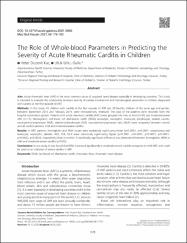The role of whole-blood parameters in predicting the severity of acute rheumatic carditis in children
Abstract
Aim: Acute rheumatic fever (ARF) is the most common cause of acquired heart disease especially in developing countries. This study is intended to evaluate the relationship between severity of cardiac involvement and hematological parameters in children diagnosed with carditis at the first episode of ARF. Methods: In this study, 45 children with carditis at the first episode of ARF and 30 healthy children of the same age and gender, between September 2015 and February 2019, were retrospectively reviewed. The data of the patients were recorded from the hospital automation system. Patients with acute rheumatic carditis (ARC) were grouped into two as mild (n=30) and moderate-severe ARC (n=15). Hemoglobin, red blood cell distribution width (RDW), leukocyte, neutrophil, monocyte, lymphocyte, platelet counts, neutrophil-to-lymphocyte (NLR), platelet-to-lymphocyte (PLR), monocyte-to-lymphocyte ratio (MLR) were compared between control and all carditis patients, mild and moderate-severe carditis. Results: In ARC patients, hemoglobin and RDW values were statistically significantly lower (p<0.0001, p=0.0001, respectively) and leukocyte, neutrophil, platelet, NLR, PLR, MLR were statistically significantly higher (p<0.0001, p<0.0001, p=0.0001, p<0.0001, p=0.0022, p=0.0032, respectively) than in control. A statistically significant difference was determined between hemoglobin, RDW in mild and moderate-severe carditis (p<0.05). Conclusions: In our study, it was found that RDW increased significantly in moderate-severe carditis compared to mild ARC and could be used as an indicator of severe carditis in ARF. © 2021 by The Medical Bulletin of İstanbul Haseki Training and Research Hospital The Medical Bulletin of Haseki published by Galenos Yayınevi.
















